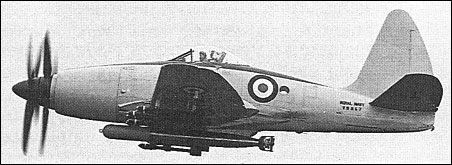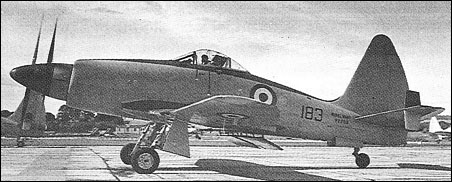|
| Almost a year before the first flight of the Wyvern TF Mk 1, the Naval Air Staff had decided to sponsor development of Britain's first turboprop-powered shipboard fighter by ordering three prototypes of the (W.35) Wyvern TF Mk 2, to Specification N.12/45. Two were to be powered by the Armstrong Siddeley Python and the third by a 4500hp Rolls-Royce Clyde. In the event, the former engine was to be preferred for production aircraft. In overall configuration and armament the Wyvern TF Mk 2 closely resembled the Mk 1, although there were differences in detail, and the first flight of the Clyde-engined prototype was made on 18 January 1949, followed by the first with a Python on 22 March 1949. Flight testing soon showed the need for modifications, noticeably to the tail unit with the progressive introduction of a larger tailplane, more fin area, dihedral on the tailplane and, eventually, finlets. Prolonged testing and development also proved necessary to achieve a satisfactory engine/propeller/throttle response system for the special demands of carrier landings, involving the two Python prototypes and most of 20 pre-series TF Mk 2s ordered in 1948 (together with a single W.38 Wyvern T Mk 3 two-seat training version). The first pre-series TF Mk 2, with a Python 2, flew on 16 February 1950, and, in June that year, became the first British turboprop aircraft to engage in carrier deck landings, aboard HMS Illustrious. The final seven pre-series aircraft were completed as Wyvern S Mk 4s, this being the designation of the definitive variant with all the handling and engine modifications, and the primary mission changed to strike. The S Mk 4 was powered by a Python 3 rated at 3670hp plus 535kg residual thrust. Production of 87 Wyvern S Mk 4s ensued, and deliveries to the first FAA squadron (No 813) began during 1953. Three other squadrons subsequently flew the Wyvern S Mk 4, front-line service continuing until March 1958. Operational use of the Wyvern during the Suez campaign in 1956 marked the only occasion on which British turboprop-powered aircraft saw combat use.
 | A three-view drawing of Wyvern S Mk.4 (800 x 548) |
| MODEL | Wyvern S Mk.4 |
| WEIGHTS |
| Take-off weight | 11113 kg | 24500 lb |
| Empty weight | 7076 kg | 15600 lb |
| DIMENSIONS |
| Wingspan | 13.42 m | 44 ft 0 in |
| Length | 12.80 m | 42 ft 0 in |
| Height | 4.57 m | 15 ft 0 in |
| Wing area | 32.98 m2 | 354.99 sq ft |
| PERFORMANCE |
| Max. speed | 613 km/h | 381 mph |
| Ceiling | 8535 m | 28000 ft |
| Range | 1464 km | 910 miles |
| trevor Webb, e-mail, 04.02.2012 06:59 Soome old copies of "Flight" suggest that the RR Clyde powered aircraft was designated TF Mk 2A. reply | | gooda, 20.06.2011 13:42 Couldn't have put it better myself... it has that look. (Sketching airplanes was how many math classes were endured back then.) reply | | bombardier, e-mail, 17.05.2011 11:49 An efective aircraft.Introduced a little too late.To Jorge
Relatively slow speed with very high powered engines was a problem that most British carrier-based aircraft of the period had
Firebrand achieved 547km /h with a 2.200hp Napier Sabre,the Typhoon with the same engine achieved around 680km /h,the Firefly with a R-R Griffon of 1.700hp achieved around 510km /h,spitfires with the same engine achieve around 660km /h.The reason for this problem was the weight of the carrier equipment reply | | Scotty, e-mail, 09.02.2010 23:55 Steve I think the Wyvern could have been as good as the Skyraider if as you say they had stuck with the Eagle, or the better of the two turboprops (IIRC they picked the wrong one). A great missed opportunity, considering people are now wanting the Skyraider back in production!! reply | |
| | Jorge, e-mail, 18.01.2010 20:27 Very nice looking to me. It had some 3600 hp, why "only" 380 mph ?
Thick wing ? Heavy ?
Himagine a Typhoon with 3600 hp... I would "fly" ! reply | | Steve, e-mail, 18.08.2009 20:49 Not the most successful of airplanes - but, considering Douglas' disaster with the A2D, Westland actually did pretty well. The turboprop was a propulsion system that took a lot more to get right than anyone expected. If the Wyvern had been continued at all, Their Lordships would've been advised to stick with the R-R Eagle and put off their desire to get rid of avgas. Too bad the Firebrand was so close and yet so very far from a Skyraider! reply | | leo rudnicki, e-mail, 22.04.2009 22:29 It probably needed the tailplane moved up mid-fin or T-tail to not mask the rudder in high alpha, ugly but so are the finlets. reply | | marcelo scudeler, e-mail, 01.03.2009 03:01 bealtiful, simple, bealtiful.... reply | | Gerry Jarvis, 08.11.2007 04:19 A contributor to FineScale Modeller magazine's latest edition (U.S.) said that the Wyvern is like the sleek fantasy airplanes you'd sketch in the back of your book during elementary-school math class. Couldn't have put it better myself... it has that look. (Sketching airplanes was how many math classes were endured back then.) reply |
|
Do you have any comments?
|
| 
COMPANY
PROFILE
All the World's Rotorcraft
|








